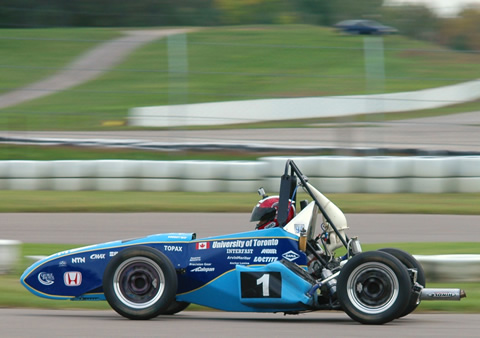At five a.m. on a recent Saturday, some 50 bleary-eyed students gathered in the Haultain Building, near College Street. There, the members of the U of T Formula SAE Racing Team boarded a bus to Mosport Race Track in Bowmanville, Ontario, where they joined 21 other schools from the Canada and the U.S. in a Formula One race, using a car that they had designed and built themselves.
As the sun rose, U of T team members were busy performing vehicle safety inspections as students from other universities worked on last-minute repairs and eyeballed their competition. Engines rumbled from 9 a.m. to 4 p.m., through patches of cloud, sun, and light rain. Most U of T team members spent the day setting up orange cones to make the race track more challenging and waving red and green flags when drivers ran into problems. When a vehicle stalled, team members sprinted into action. Sometimes a quick fix was all that was needed. When more time was needed to diagnose the problem, the students pushed the car back to the pit area.
In the end, the École de technologie supérieure of the Université du Québec won the day, finishing with the fastest average time (69.127 seconds) and the fastest driver (67.926 seconds). Michael Bakaic, a fourth-year engineering student and the U of T team captain, said the winning team succeeded because they had built a smaller, lighter engine. “A good race car needs to be very light and have lots of power,” he said. Rochester Institute of Technology placed second and Missouri S&T came in third. As host, U of T entered a car but did not officially compete.
Members of U of T’s Formula SAE team are involved in every aspect of building the car, from initial design through manufacturing, prototyping, physical testing and development. Rookies start with basic, hands-on work such as grinding tubes that will go in the vehicle’s chassis. Section leaders may give them background reading and other assignments. Whatever their contribution, “students get the chance to take what they learn in classrooms and do it,” says Bakaic. U of T first raced a car in 1999, and won the world championship in 2003.
Over the next several months, in preparation for the 2011 race, team members will squeeze in Formula SAE among school and other commitments; the keen ones will pull all-nighters at the shop. By February or March, they’ll have the satisfaction of seeing the car come to life and be able to point out the part they contributed. “When I saw that car run for the fist time, it was so incredible,” says Amanda Santos, a second-year mechanical engineering student and the team’s manager.
A few get an even more thrilling reward: a spin around the track in the driver’s seat. “You really feel that there’s no car around you and you feel that your body is going that fast,” said Bakaic, one of several drivers for the team. (The car goes from zero to 100 kilometres per hour in three seconds. It could go faster, but the engine is geared down for safety.) For Santos, the driver’s seat is another learning opportunity: “I don’t even have my G1 yet, but I want to be the first female driver on the team,” she says.
Recent Posts
People Worry That AI Will Replace Workers. But It Could Make Some More Productive
These scholars say artificial intelligence could help reduce income inequality
A Sentinel for Global Health
AI is promising a better – and faster – way to monitor the world for emerging medical threats
The Age of Deception
AI is generating a disinformation arms race. The window to stop it may be closing





